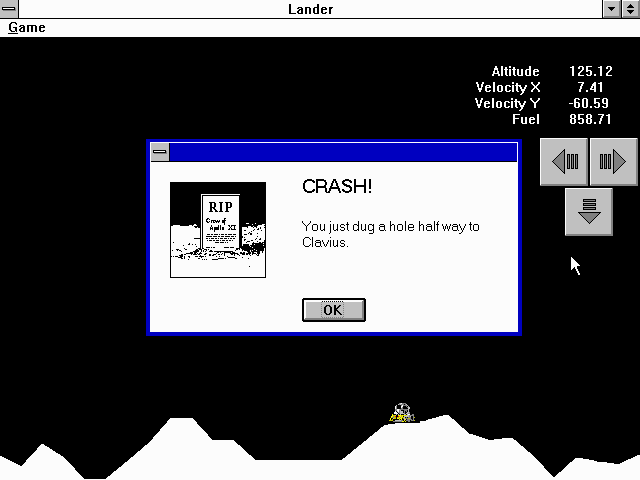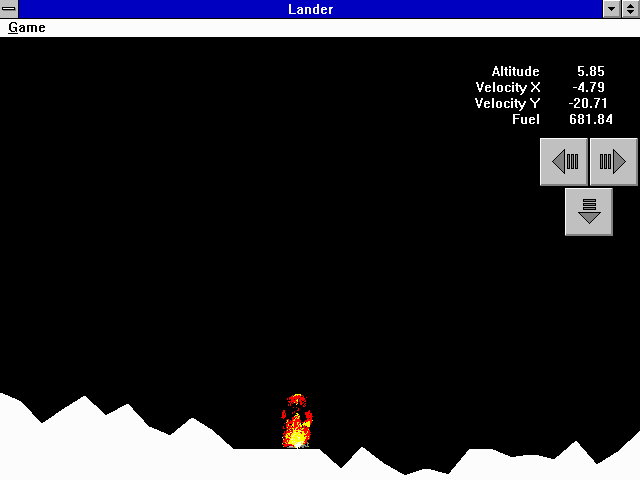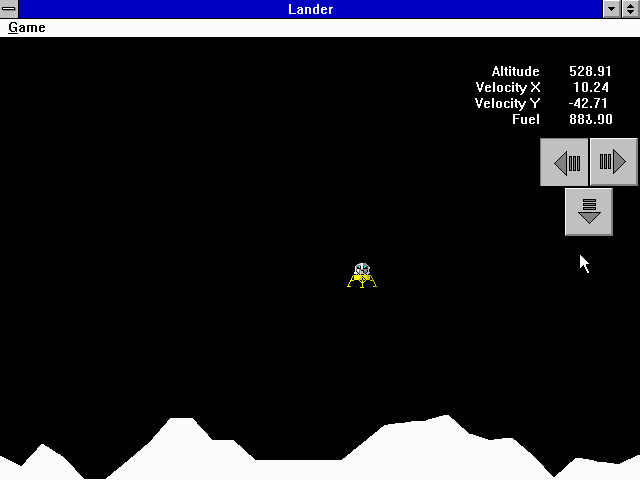Retro Replay Review
Gameplay
Lander delivers a deceptively simple concept that quickly reveals its depth through precision and patience. You pilot a lunar lander from an external vantage point, scanning the rugged moon terrain below for a safe spot. The core mechanic revolves around firing thrusters in three directions—left, right, and down—to manage your horizontal and vertical velocity, all while conserving precious fuel. This minimalist setup guarantees that every decision matters, turning each descent into a tense, strategy-driven puzzle.
(HEY YOU!! We hope you enjoy! We try not to run ads. So basically, this is a very expensive hobby running this site. Please consider joining us for updates, forums, and more. Network w/ us to make some cash or friends while retro gaming, and you can win some free retro games for posting. Okay, carry on 👍)
The fuel constraint adds a thrilling layer of resource management to the challenge. You can’t afford to blast full throttle at every moment; instead, you must carefully modulate thrusts to correct drift, counteract gravity, and soften your touchdown. As you progress, the available landing zones shrink and the landscape grows increasingly jagged, requiring surgical precision and an intimate understanding of the lander’s momentum. Moments of near-miss landings become memorable highlights, showcasing how a single miscalculated burn can send you tumbling across the lunar plains.
Controls are intuitive yet demand skill. The responsive thrusters feel weighty enough to mimic realistic inertia, but they never become unwieldy. Trial-and-error sessions sharpen your instincts, turning frustration into mastery. For players seeking a steady ramp-up in difficulty, Lander’s learning curve feels fair but firm. You’ll soon find yourself adjusting to each slope and crater, anticipating gravitational pull before it wrenches your craft off-course. The sense of accomplishment upon a flawless landing is immensely rewarding.
Graphics
Graphics in Lander strike a balance between functional clarity and atmospheric charm. The moon’s surface is rendered in stark monochrome or subtle grayscale tones, punctuated by jagged rocks, steep cliffs, and occasional dust plumes. While it leans toward the minimalist side, each polygonal ridge and crater is clearly defined, reducing visual noise and helping you identify suitable landing areas at a glance.
Particle effects are used sparingly but effectively. Downward firings stir halos of dust that swirl around your lander’s pads, lending a visceral sense of proximity to the surface. When a landing goes awry, sparks and debris scatter realistically, reinforcing the game’s emphasis on physics-based consequences. These small visual flourishes heighten tension without overwhelming the streamlined aesthetic.
The user interface remains unobtrusive, with fuel gauges and velocity readouts displayed along the edges of the screen. Text and icons are sharp and legible, ensuring vital information is always in clear view. Although there’s no flashy animation or colorful palette, the game’s visuals are perfectly matched to its purpose: to immerse players in the unforgiving challenge of piloting a delicate craft across a barren, gravity-warped landscape.
Story
At first glance, Lander appears to have minimal narrative trappings—but a subtle backstory enriches the experience. You assume the role of an unmanned survey mission operator sent to map uncharted lunar territories. Brief mission logs between levels hint at corporate objectives, scientific discoveries, and the ever-present pressure to conserve resources. These logs build a quiet sense of progression as you advance through successive landing zones.
Each unlocked region reveals snippets of context: references to past expeditions, cryptic warnings about unstable ground, and communications from mission control. While there’s no traditional cutscene or voiced dialogue, the narrative emerges through environmental design and mission briefings. This approach respects the solitary, mechanical feel of lunar exploration, placing you squarely in the cockpit with only your instruments and wits to rely on.
Though the storyline isn’t front-and-center, it provides enough thematic scaffolding to sustain engagement over multiple runs. The gradual unveiling of mission parameters and new objectives creates a light campaign structure, rewarding curiosity and completion of side challenges. By the time you touch down on the final plateau, you’ll feel connected to the game’s understated lore—and eager to tackle your next hypothetical assignment.
Overall Experience
Lander shines as a pure, unfiltered simulation of lunar touchdown challenges. Its streamlined presentation, paired with razor-sharp physics, makes for a compelling test of patience and precision. Whether you’re a fan of retro arcade-style piloting games or simply seeking a measured, contemplative experience, Lander offers a refreshingly focused take on the genre.
The game’s difficulty curve is well-calibrated: early missions teach you basic thrust control and landing zone identification, while later stages push you to master fuel efficiency and rapid response. Occasional frustration on failed attempts is offset by the delight of controlled glides and perfect touchdowns. It’s an ideal balance for players who enjoy incremental progress and the satisfaction of problem-solving under pressure.
With its minimalist visuals, clear UI, and niche appeal, Lander may not suit those craving story-driven epics or flashy graphics. However, for anyone intrigued by physics-based challenges and the romance of space exploration, it delivers a polished, engrossing experience. Piloting a lander over the moon’s surface has seldom felt so tense, rewarding, and pure in its design. This is one small step for you, one giant leap for your high-score pursuits.
 Retro Replay Retro Replay gaming reviews, news, emulation, geek stuff and more!
Retro Replay Retro Replay gaming reviews, news, emulation, geek stuff and more!









Reviews
There are no reviews yet.